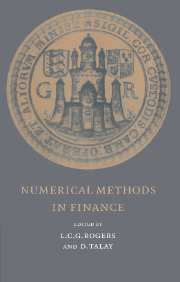Book contents
- Frontmatter
- Contents
- Contributors
- Introduction
- Convergence of Numerical Schemes for Degenerate Parabolic Equations Arising in Finance Theory
- Continuous-Time Monte Carlo Methods and Variance Reduction
- Recent Advances in Numerical Methods for Pricing Derivative Securities
- American Options: A Comparison of Numerical Methods
- Fast, Accurate and Inelegant Valuation of American Options
- Valuation of American Option in a Jump-diffusion Models
- Some Nonlinear Methods for Studying Far-from-the-money Contingent Claims
- Monte Carlo Methods for Stochastic Volatility Models
- Dynamic Optimization for a Mixed Portfolio with Transaction Costs
- Imperfect Markets and Backward Stochastic Differential Equations
- Reflected Backward SDEs and American Options
- Numerical Methods for Backward Stochastic Differential Equations
- Viscosity Solutions and Numerical Schemes for Investment/Consumption Models with Transaction Costs
- Does Volatility Jump or Just Diffuse? A Statistical Approach
- Martingale-Based Hedge Error Control
- The Use of Second-Order Stochastic Dominance To Bound European Call Prices: Theory and Results
American Options: A Comparison of Numerical Methods
Published online by Cambridge University Press: 05 June 2012
- Frontmatter
- Contents
- Contributors
- Introduction
- Convergence of Numerical Schemes for Degenerate Parabolic Equations Arising in Finance Theory
- Continuous-Time Monte Carlo Methods and Variance Reduction
- Recent Advances in Numerical Methods for Pricing Derivative Securities
- American Options: A Comparison of Numerical Methods
- Fast, Accurate and Inelegant Valuation of American Options
- Valuation of American Option in a Jump-diffusion Models
- Some Nonlinear Methods for Studying Far-from-the-money Contingent Claims
- Monte Carlo Methods for Stochastic Volatility Models
- Dynamic Optimization for a Mixed Portfolio with Transaction Costs
- Imperfect Markets and Backward Stochastic Differential Equations
- Reflected Backward SDEs and American Options
- Numerical Methods for Backward Stochastic Differential Equations
- Viscosity Solutions and Numerical Schemes for Investment/Consumption Models with Transaction Costs
- Does Volatility Jump or Just Diffuse? A Statistical Approach
- Martingale-Based Hedge Error Control
- The Use of Second-Order Stochastic Dominance To Bound European Call Prices: Theory and Results
Summary
Introduction
The overwhelming majority of traded options are of American type. Yet their valuation, even in the standard case of a lognormal process for the underlying asset, remains a topic of active research. This situation stems from the nature of the solution which requires the determination of the optimal exercise strategy as well as the value of the option. In contrast the European option, which can only be exercised at its expiration date, has been valued by the celebrated Black–Scholes formula (Black & Scholes 1973) for the standard financial model.
Due to a lack of closed–form solutions to American option valuation problems, a vast array of approximation schemes has been advanced. The Broadie & Detemple article in this volume provides a summary of some experimental results. The present article is a detailed account of comparative experiments conducted with numerical schemes including the recent method of Carr & Faguet 1996. It is organized as follows: Section 2 reviews the basic Black–Scholes model, Section 3 presents the approximation approaches and Section 4 concludes with some benchmark comparisons.
The Standard Model
The prototypical definition of an American option is that of a contract giving its holder the right to buy (call option) or sell (put option) one unit of an underlying security (e.g. stock) at a pre–arranged price K. This right can be exercised at any time before an expiration date T. In contrast, a European option can be exercised at the expiration date only.
- Type
- Chapter
- Information
- Numerical Methods in Finance , pp. 67 - 87Publisher: Cambridge University PressPrint publication year: 1997
- 24
- Cited by



